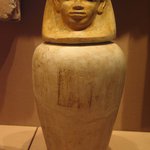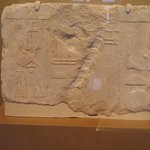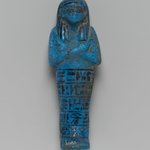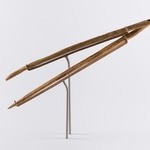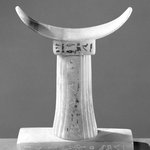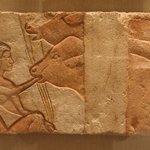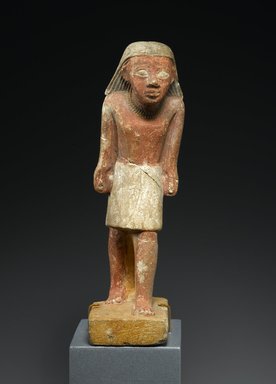

Statuette of a Striding Man, ca. 2288–2170 B.C.E. Limestone, pigment, 6 3/4 × 1 7/8 × 3 1/8 in. (17.1 × 4.8 × 7.9 cm). Brooklyn Museum, Gift of Evangeline Wilbour Blashfield, Theodora Wilbour, and Victor Wilbour honoring the wishes of their mother, Charlotte Beebe Wilbour, as a memorial to their father, Charles Edwin Wilbour, 16.238. Creative Commons-BY (Photo: Brooklyn Museum, 16.238_front_PS2.jpg)

Statuette of a Striding Man, ca. 2288–2170 B.C.E. Limestone, pigment, 6 3/4 × 1 7/8 × 3 1/8 in. (17.1 × 4.8 × 7.9 cm). Brooklyn Museum, Gift of Evangeline Wilbour Blashfield, Theodora Wilbour, and Victor Wilbour honoring the wishes of their mother, Charlotte Beebe Wilbour, as a memorial to their father, Charles Edwin Wilbour, 16.238. Creative Commons-BY (Photo: Brooklyn Museum, CONS.16.238_2002_xrs_detail01.jpg)
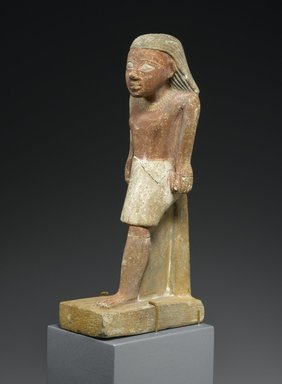
Statuette of a Striding Man, ca. 2288–2170 B.C.E. Limestone, pigment, 6 3/4 × 1 7/8 × 3 1/8 in. (17.1 × 4.8 × 7.9 cm). Brooklyn Museum, Gift of Evangeline Wilbour Blashfield, Theodora Wilbour, and Victor Wilbour honoring the wishes of their mother, Charlotte Beebe Wilbour, as a memorial to their father, Charles Edwin Wilbour, 16.238. Creative Commons-BY (Photo: Brooklyn Museum, 16.238_threequarterfront_PS2.jpg)

Statuette of a Striding Man, ca. 2288–2170 B.C.E. Limestone, pigment, 6 3/4 × 1 7/8 × 3 1/8 in. (17.1 × 4.8 × 7.9 cm). Brooklyn Museum, Gift of Evangeline Wilbour Blashfield, Theodora Wilbour, and Victor Wilbour honoring the wishes of their mother, Charlotte Beebe Wilbour, as a memorial to their father, Charles Edwin Wilbour, 16.238. Creative Commons-BY (Photo: Brooklyn Museum, CUR.16.238_tlf.jpg)

Statuette of a Striding Man, ca. 2288–2170 B.C.E. Limestone, pigment, 6 3/4 × 1 7/8 × 3 1/8 in. (17.1 × 4.8 × 7.9 cm). Brooklyn Museum, Gift of Evangeline Wilbour Blashfield, Theodora Wilbour, and Victor Wilbour honoring the wishes of their mother, Charlotte Beebe Wilbour, as a memorial to their father, Charles Edwin Wilbour, 16.238. Creative Commons-BY (Photo: Brooklyn Museum, 16.238_threequarterback_PS2.jpg)
Statuette of a Striding Man
Egyptian, Classical, Ancient Near Eastern Art
All three statues would have been used in the tomb as a place for the ka-soul to reside and accept food offerings for the deceased from the living.
- Possible place collected: Diospolis Parva, Egypt
- Possible place collected: Arika (Gebel el-Araq?), Egypt
- Possible place collected: Hiw, Egypt










